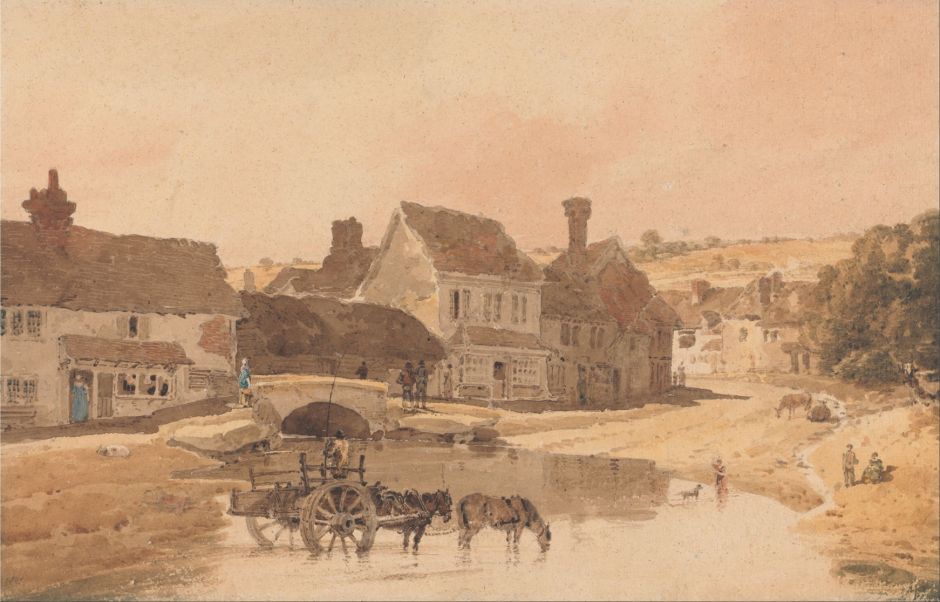Few landscape paintings are made so far from the landscape that figures could not be seen in that view.

A good example of one of those few is this overwhelmingly detailed and distant view of Florence from Bellosguardo, painted in 1863 by the Pre-Raphaelite landscape artist John Brett. The closest which it manages to a foreground, in the cemetery and scrub at the lower edge, might just attain visible figures, but in the circumstances they would be too insignificant against the city itself.

Sometimes, those foreground figures are vital for instilling a sense of scale to the whole view. James Ward’s vast and imposing painting of Gordale Scar (1812–15) benefits greatly from the herds of cattle and deer at its foot. Without them it would be easy to misjudge the scale of the cliff faces and the huge cleft in them.

In most pure landscape paintings, the figures – no matter how artificial they might have been in their creation – are part of that landscape. Thomas Girtin’s Village of Kirkstall (1801) has villagers, who go about their lives in the middle of his motif. A farmer lets the two horses drawing his cart drink from the river, and others walk or stand along the main street.
Girtin astutely uses his staffage to add some contrasting colours, and to enhance the overall atmosphere. No one is rushing here, indeed the figures are almost as static as the fixtures and fittings like the buildings and bridge. Even the mirror-like surface of the river is in no hurry to flow downstream.
These figures are pure staffage: a word actually borrowed from German, but formed in pseudo-French, from staffiren, meaning to fit out or garnish. It is properly used to describe all the accessories of a picture or painting, but most commonly applies to the human and animal figures, and their mobile equipment such as the cart in Girtin’s watercolour. It could equally be used of vegetation and other objects which were not in the original view, but were added by the artist for ‘effect’, such as some trees used for repoussoir.

The implication of staffage is that it is generally neutral in influence. Girtin’s cart and villagers add a little to the atmosphere, but are hardly stylistic, narrative, or meaningful. In Salvator Rosa’s Rocky Landscape with a Huntsman and Warriors (c 1670), those figures are working rather harder, and are quite crucial to Rosa’s whole style, and the desperation of the landscape.
Just as Rosa’s weather and crags are romantic hyperbole, so his figures augment that hyperbole. They’re not peaceful village folk staring at a young painter with his watercolours, but desperados, brigands, criminals, murderers. They exist somewhere between staffage and side-narrative.

Narrative is also not an all-or-nothing concept. With moderately large, well-attributed figures clearly telling a story from a well-known source, there’s no doubt about the motif being the figures, and the landscape as its ground. But that is hardly the case in George Morland’s Winter Landscape with Figures (c 1785).
A man has slipped over on a frozen pond, and is struggling to get up, his walking stick resting beside him. A girl is gingerly making her way across the ice, her feet far apart to spread the load and avoid her own slippage. A younger boy stands at the edge with his mother, who is carrying two pails. Beside her is a small dog, and behind that are three donkeys looking on.
There is a narrative here, but it is hardly central to Morland’s painting, more a touch of wry and seasonal humour. Remove those figures and it does not transform the painting, although it would be the poorer without them. It’s another little device by which the artist converses with the viewer, just as did Fearnley.

Staffage is even less appropriate when much of the substance of the landscape are its inhabitants, as in Richard Parkes Bonington’s Fishmarket near Boulogne (1824). His fishmarket is the people, with the backdrop of the sails of the fishing boats illuminated in his golden light. Yet many of those figures are gestural, only partly formed or suggested: it is the mass of their assembly which is such an important part of his motif.

We are also on difficult ground when dealing with some artists who decorated their grand landscapes with little enigmatic and possibly highly meaningful clusters of figures. I will return to look at Frederic Edwin Church’s use of figures in another article, but those in The Heart of the Andes (1859) have the semblance of some greater meaning: the small group around a prominent crucifix at the lower left is of particular interest, despite their tiny size in such an imposing landscape.

Finally, there is the greatest problem of them all, the few possibly ‘pure’ landscapes painted by Nicolas Poussin, such as his Landscape with a Calm (c 1651). Entire books have been written about their close reading, and still we are none the wiser. Are they just staffage and accessories, or do they form a narrative, and if so, is that central to the painting or just marginal entertainment?
We are trapped in a catch-22: when we can read the painting, the meaning and relevance of the figures is clear. But to read the painting, we need to read the figures too.

